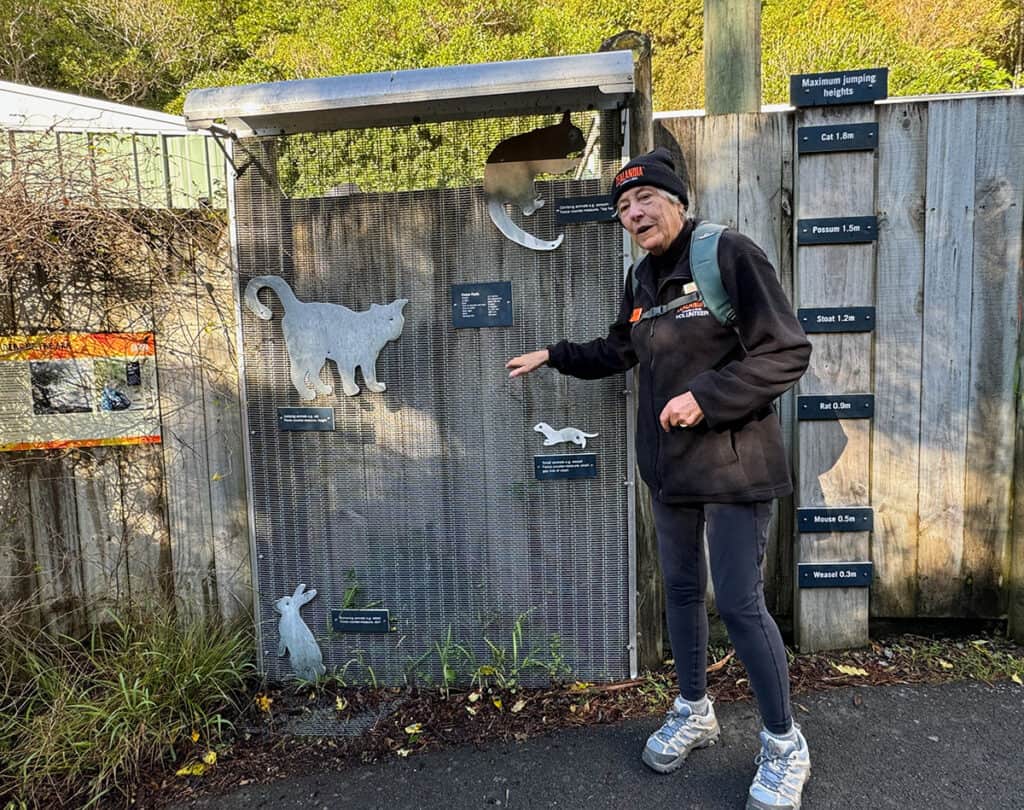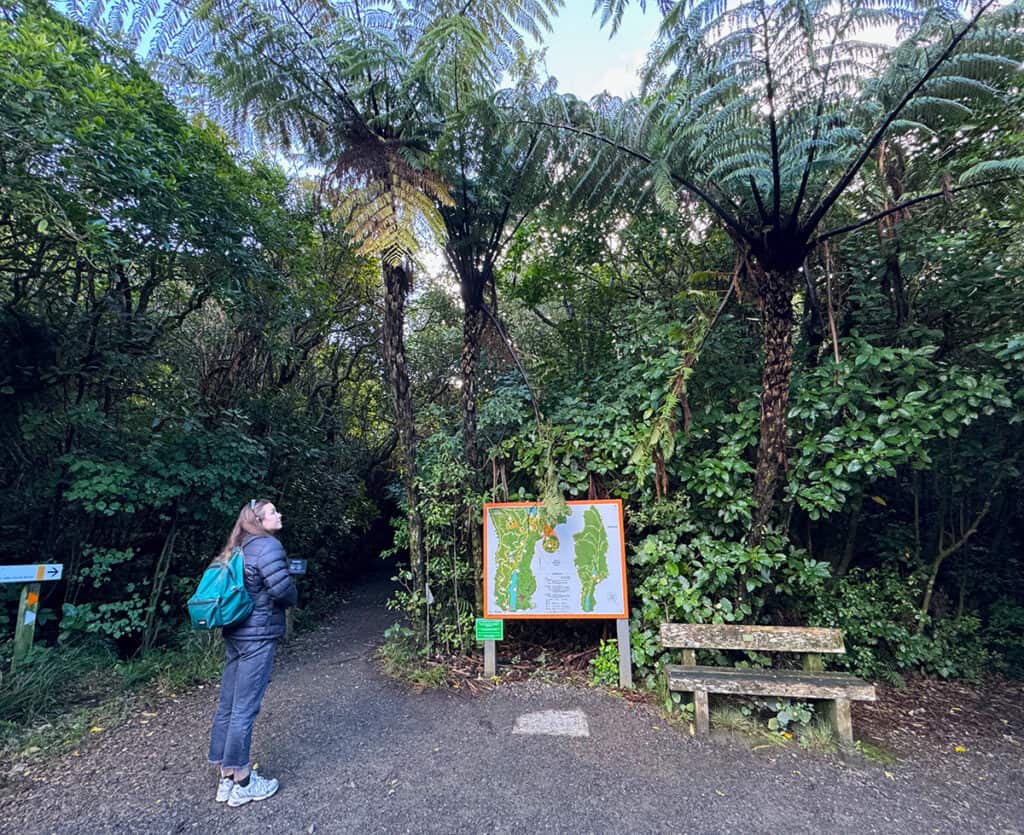It was my umpteenth visit to Wellington, but my first visit to Zealandia.
This 225-hectare (500-acre) piece of native paradise, just up the Cable Car from Lambton Quay, was not really on my radar when paired alongside shopping, eating, and Te Papa Museum. But shame on me!

It was a lovely sunny, winter’s day in New Zealand’s capital city, and my sister was driving down from Hawke’s Bay, so I had most of the day to kill. If you know my sister, you know she’s a shopper. I’m no where near as good as she is, so I needed to save my stamina for the next day to join her.
In past trips I have zipped around Wellington doing things you won’t find in the guide books, but I’ve never been to Zealandia Te Māra a Tāne, so today was the day.
I had a leisurely start to my morning, pottering here on the blog, then got dressed and headed out. We were staying at the (very basic) Ibis Hotel. It’s 3-stars, but it’s located in a great spot for easy access to Lambton Quay, and the waterfront restaurants just a block in the other direction. It’s clean and the bed is very comfy. What more do ya need?!
I walked to the Wellington Cable Car and paid my $11 for the return trip, then up I went through the neon lit disco tunnels, stopping a couple of times to let passengers on and off as the city receded below and the view opened over the harbour. Five minutes, and 610 metres later, we arrived at the top at Kelburn.

The views from up here are on all the postcards of Wellington, and it was just a perfect sunny day with a flat ocean belying what tricks this city can pull on other days.
The Botanic Garden winds its way all the way back down from here, but as it was winter and botany needs spring or summer to really be in bloom, I thought I’d save the walk down for next time.
As providence would have it, the Cable Top Eatery is a fine cafe perched atop the same hill upon which I had disembarked. My plan was to have coffee and a little something that I shall call breakfast. Or morning tea. A freshly baked carrot muffin with a decadent swirl of cream cheese icing, washed down with a trim flat white looking out at that view. Bliss.

Out the front of the cafe and cable car, the free Zealandia shuttle van runs every ten minutes to take the eco-curious to this hidden gem in the heart of the city.
I waited for a few moments, and Paul arrived. I was his only passenger, so off we went on the two-kilometre drive, with him giving me his spiel about the sanctuary. He’s done it a few times, as he barely stopped to draw breath and it was quite international-visitor centric, but I asked him a few questions, and made a few ohhs and indeeds.
It isn’t far, but as I am quite dyslexic with Google maps, I was glad he drove me. I did walk back – and took off for a kilometre towards Karori, in the wrong direction, before turning my phone upside down and figuring it out.

I had timed my arrival perfectly though to join a two-hour guided walk, so decided it was worth the $60 (it’s $24 to wander on your own). I was so glad I did too.
Philippa was our wonderfully knowledgeable guide, in her 70s I would say, fit as a fiddle and a wealth of information about the birds, reptiles, and flora we asked her about. She was once a science teacher, and had worked all over the world, travelling with her diplomat husband, and now she volunteers here, taking visitors around this garden of Eden in our capital city.

We started by watching a five-minute video depicting what New Zealand was like before the arrival of humans, when giant moa roamed the landm until they were hunted to extinction by Maori. Then when European explorers arrived bringing rodents, pigs, goats and other “food supplies”. They burned off huge swathes of native forest to build houses and farm the land.
Zealandia was created to be an urban eco-sanctuary, and is the largest in the world so close to a major city. It is completely surrounded by a predator fence, and thus is home to our precious birds: kiwi, takahe, korimako (bellbird) and the tuatara, as well as many more feathered friends.

To walk with Philippa, and our little booklet with pictures of which birds and wildlife to look for, was like being on a treasure hunt, gazing up into the trees, our eyes darting at every movement spotting the prizes.

What are the chances?!
But what are the chances that while everyone is looking way up into the tree tops where Tuis are flitting about above the leaves and branches, that the poo that I saw exit said Tui would land on my face.
Turns out, 100% On my top lip to be exact. Well the gap between my nose and lips. Lucky my mouth was closed! Best buy a Lotto ticket.

This area was chosen, back in 1998, because it once homed two concrete dams and water reservoirs, built in 1878, in the valley. But when it was subsequently discovered that this was also a fault line, it became imperative to decommission the reservoirs and dams, lest a mighty shake cause it to crack and take out all of Karori, if not the city below.

In 1999 the 500-acre area was fully fenced with 8.6 kilometres of clever predator fencing, after time was spent testing how high pests like rodents, possums, rabbits and cats could jump, burrow and climb.
It is checked three times a week and volunteers work to ensure traps are constantly baited and checked. Turns out baby mice can flatten themselves and slip through the 1cm gap, so as the fence is replaced, the lower part will have a different mesh.

Some trees here are about 100 years old, but Zealandia has a 500-year plan to ensure our native wildlife does not go the way of the moa, huia and about 80 other New Zealand bird species.
It was only until recently we thought the takahe was extinct, but there is one here – Orbell, who is 19 years old, and who was not at all bothered by us taking his photo.
Update: Orbell went missing in October 2024 and staff suspect he has gone to find his final resting place.


Book your Zealandia Tour
General Admission to Zealania is $24 per adult, $30 for children aged 5+, free for under 5s. But I highly recommend you do one of the three-times daily guided tours with a lovely volunteer guide. You can always stay on in the sanctuary afterwards, but I promise you’ll see so much – and know what you’re looking at!
There are three levels of tracks depending on your level of mobility or fitness. Some are suitable for wheelchairs and pushchairs, others for moderate walking and others include steep or slippery tracks for those with good fitness – and shoes!
Book your guided Zealandia by Day tour here to explore for two hours, then remain in the park as long as you like.
There is also a Zealandia By Night tour, with an experienced guide and you’ll walk the easy paths and tracks by torchlight. If you do this walk you’re pretty much guaranteed to see Kiwi in their natural environment. Next time, I’d like to do this one.

